The number of children born in Japan is shrinking every year. But despite the declining birthrate, the availability of food related items with child appeal in Japan indicates that entertaining young diners at meal time remains a high priority. Almost every Japanese restaurant serves children’s meals on special plates shaped like fire engines or race cars, and department stores offer a wide variety of child-sized chopsticks, forks and spoons decorated with cartoon characters.
So it’s hardly surprising that hashioki shaped like omocha or toys are popular, too.

These hashioki, one lacquer and one ceramic, are in the shape of spinning tops. They actually work, so they could conceivably keep a child entertained while he or she is waiting to put their chopsticks to use.
 This hashioki portrays a kendama, or wooden ball-and-stick toy. The object of the game is to throw the wooden ball, which is attached to the stick with a string and has a hole drilled into it, in the air and then catch it on the pointy end of the handle. It may be a child’s toy, but I can report from experience that it’s a very challenging test of hand-eye coordination for adults, too.
This hashioki portrays a kendama, or wooden ball-and-stick toy. The object of the game is to throw the wooden ball, which is attached to the stick with a string and has a hole drilled into it, in the air and then catch it on the pointy end of the handle. It may be a child’s toy, but I can report from experience that it’s a very challenging test of hand-eye coordination for adults, too.
 This taketombo or bamboo dragonfly is a simple shaft with a propeller attached to one end. Traditionally it was carved from bamboo, although today they are also made from plastic. It is similar to the old-fashioned whirly gig in the United States. The idea is to rub the shaft between your hands and then release it, hoping that the rotating propeller will make it fly. Apparently there are or once were competitions in Japan where contestants carved a taketombo on site and then competed to see whose toy would fly highest or farthest.
This taketombo or bamboo dragonfly is a simple shaft with a propeller attached to one end. Traditionally it was carved from bamboo, although today they are also made from plastic. It is similar to the old-fashioned whirly gig in the United States. The idea is to rub the shaft between your hands and then release it, hoping that the rotating propeller will make it fly. Apparently there are or once were competitions in Japan where contestants carved a taketombo on site and then competed to see whose toy would fly highest or farthest.
The hashioki on the left below shows a deflated kamifusen, or paper balloon, which were reportedly created by the wives of fishermen as an off-season craft.
This hashioki on the right depicts an inu hariko, or paper mache dog, which appears to be a sort of companion piece to the maneki neko, or lucky cat. Hariko (paper mache) is a craft
that came to Japan from China somewhere between the 14th. and 16th. centuries. This dog symbolizes loyalty and protection, which real dogs often provide, and is also considered to be a charm for an easy childbirth.
This scowling hashioki portrays a yakko or samurai’s servant from Japan’s Tokugawa era (1603-1867), when the country was ruled by shoguns. The yakko acted like a kind of  forward bearer, clearing the way for a samurai, which sometimes included shoving lowly townspeople out of the way. It is still a popular design for kites in Japan, and is also often featured on New Year’s cards.
forward bearer, clearing the way for a samurai, which sometimes included shoving lowly townspeople out of the way. It is still a popular design for kites in Japan, and is also often featured on New Year’s cards.

Baseball was first introduced to Japan in 1872 by an American who taught English at the school that eventually evolved into Tokyo University. It is called yakyuu in Japan, which is a pronunciation of the kanji 野 meaning “field” and the kanji 球 meaning “ball.” Baseball remains a popular sport in Japan today, at both the amateur and professional levels.
While omocha may be playthings for children, their popularity as hashioki also suggests that they are also evocative nostalgia items for those who are far removed from their childhood years.
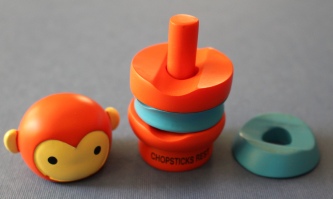
 Katoh produces an extensive line of other exceedingly cute merchandise, but these edamame hashioki are among his best. Each of the four rests has unique eye decorations, and they nestle together in their own soy bean shell holder. There is also a two bean version of this design.
Katoh produces an extensive line of other exceedingly cute merchandise, but these edamame hashioki are among his best. Each of the four rests has unique eye decorations, and they nestle together in their own soy bean shell holder. There is also a two bean version of this design. packaged inside its’ own ceramic hot pot. The hashioki represent five popular yosenabe or Japanese hot pot ingredients, including crab, mushroom, spring onions, kamaboko or fish sausage, and daikon radish half moons.
packaged inside its’ own ceramic hot pot. The hashioki represent five popular yosenabe or Japanese hot pot ingredients, including crab, mushroom, spring onions, kamaboko or fish sausage, and daikon radish half moons.


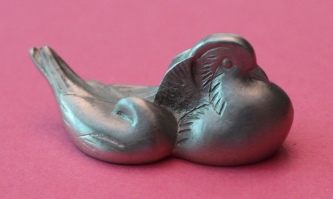 In any case, , Mandarin ducks should always be in pairs, like this metal example where the smaller and presumably female bird nestles beneath the wing of the larger bird. These ducks are physically attached, so they are unquestionably mated for life.
In any case, , Mandarin ducks should always be in pairs, like this metal example where the smaller and presumably female bird nestles beneath the wing of the larger bird. These ducks are physically attached, so they are unquestionably mated for life.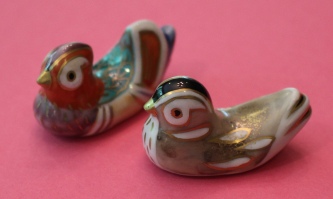 female duck; in human pairs the female is usually the more brightly attired member of the pair. Maybe Japanese female ducks are simply into minimalist fashion.
female duck; in human pairs the female is usually the more brightly attired member of the pair. Maybe Japanese female ducks are simply into minimalist fashion.
 This hashioki portrays a kendama, or wooden ball-and-stick toy. The object of the game is to throw the wooden ball, which is attached to the stick with a string and has a hole drilled into it, in the air and then catch it on the pointy end of the handle. It may be a child’s toy, but I can report from experience that it’s a very challenging test of hand-eye coordination for adults, too.
This hashioki portrays a kendama, or wooden ball-and-stick toy. The object of the game is to throw the wooden ball, which is attached to the stick with a string and has a hole drilled into it, in the air and then catch it on the pointy end of the handle. It may be a child’s toy, but I can report from experience that it’s a very challenging test of hand-eye coordination for adults, too. This taketombo or bamboo dragonfly is a simple shaft with a propeller attached to one end. Traditionally it was carved from bamboo, although today they are also made from plastic. It is similar to the old-fashioned whirly gig in the United States. The idea is to rub the shaft between your hands and then release it, hoping that the rotating propeller will make it fly. Apparently there are or once were competitions in Japan where contestants carved a taketombo on site and then competed to see whose toy would fly highest or farthest.
This taketombo or bamboo dragonfly is a simple shaft with a propeller attached to one end. Traditionally it was carved from bamboo, although today they are also made from plastic. It is similar to the old-fashioned whirly gig in the United States. The idea is to rub the shaft between your hands and then release it, hoping that the rotating propeller will make it fly. Apparently there are or once were competitions in Japan where contestants carved a taketombo on site and then competed to see whose toy would fly highest or farthest.

 forward bearer, clearing the way for a samurai, which sometimes included shoving lowly townspeople out of the way. It is still a popular design for kites in Japan, and is also often featured on New Year’s cards.
forward bearer, clearing the way for a samurai, which sometimes included shoving lowly townspeople out of the way. It is still a popular design for kites in Japan, and is also often featured on New Year’s cards.
 Otaku is an honorific form of a Japanese word meaning home (taku), and the term is actually a sarcastic reference to someone who spends hours in their home in order to obsessively focus on a hobby or interest. Often described as a geek or a nerd, the word usually suggests someone who is uncomfortable interacting with their peers or other humans, and who exhibits anti-social behavior. Otaku are almost always males.
Otaku is an honorific form of a Japanese word meaning home (taku), and the term is actually a sarcastic reference to someone who spends hours in their home in order to obsessively focus on a hobby or interest. Often described as a geek or a nerd, the word usually suggests someone who is uncomfortable interacting with their peers or other humans, and who exhibits anti-social behavior. Otaku are almost always males. otaku, camera otaku, railroad otuku, and many more varieties. The debonair bow tie on this hashioki looks like a fashion otaku, or young man who is obsessed with dressing like a dandy.
otaku, camera otaku, railroad otuku, and many more varieties. The debonair bow tie on this hashioki looks like a fashion otaku, or young man who is obsessed with dressing like a dandy. To the casual observer, these hashioki appear to depict geisha. But the women’s long sleeves and obi dangling down their back actually identify them as maiko.
To the casual observer, these hashioki appear to depict geisha. But the women’s long sleeves and obi dangling down their back actually identify them as maiko. colored than those worn by geisha, and the okobo sandals they wear with their kimono were even higher and more precarious than the standard geta.
colored than those worn by geisha, and the okobo sandals they wear with their kimono were even higher and more precarious than the standard geta. opportunity to glimpse a maiko or geisha as they travel to a teahouse or other assignation in the early evening hours. However, the maiko you see today may in fact be tourists who have paid to be dressed that way.
opportunity to glimpse a maiko or geisha as they travel to a teahouse or other assignation in the early evening hours. However, the maiko you see today may in fact be tourists who have paid to be dressed that way.

 These tokkuri, or sake bottles with attached cups, show three geisha as they were captured by famous ukiyo-e artist Kitagawa Utamaro. It seems entirely appropriate to decorate a sake bottle with a geisha picture, as keeping a client’s sake cup filled was usually part of a geisha’s service.
These tokkuri, or sake bottles with attached cups, show three geisha as they were captured by famous ukiyo-e artist Kitagawa Utamaro. It seems entirely appropriate to decorate a sake bottle with a geisha picture, as keeping a client’s sake cup filled was usually part of a geisha’s service.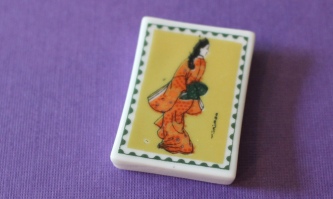 “Turning Back Beauty” painting was created in the late 17th. century many of the geisha portrayed were actually men playing the roles of women in the kabuki theatre. Japanese authorities thought that prohibiting women from working as entertainers or actors would reduce the likelihood of prostitution… but like most easy fixes, it didn’t completely solve the problem.
“Turning Back Beauty” painting was created in the late 17th. century many of the geisha portrayed were actually men playing the roles of women in the kabuki theatre. Japanese authorities thought that prohibiting women from working as entertainers or actors would reduce the likelihood of prostitution… but like most easy fixes, it didn’t completely solve the problem.

















 the head of the user. “For years, the most commonly used form [for hashioki] was that of the pillow,” writes H. Elliott McClure. “Gradually it came in different colors and patterns, but still retaining the pillow form.”(1) Some ceramic pillows had holes in the sides which could be filled with hot water in winter, as the painted dots on either side of this example suggest.
the head of the user. “For years, the most commonly used form [for hashioki] was that of the pillow,” writes H. Elliott McClure. “Gradually it came in different colors and patterns, but still retaining the pillow form.”(1) Some ceramic pillows had holes in the sides which could be filled with hot water in winter, as the painted dots on either side of this example suggest.


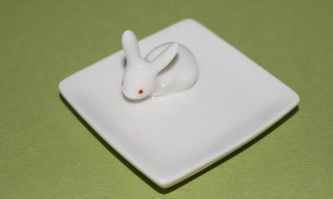





 with tiny ceramic pillows to rest the tips on…”(2) Having observed Dalby’s careful eye for detail in her non-fiction books, I assume the American anthropologist purposely used the word pillows to allude to the hashioki used in a place where people sleep.
with tiny ceramic pillows to rest the tips on…”(2) Having observed Dalby’s careful eye for detail in her non-fiction books, I assume the American anthropologist purposely used the word pillows to allude to the hashioki used in a place where people sleep. right away I needed to have that too, because this little ornament was a place for resting your chopsticks, a way to stop eating for a few moments, to admire your table, to look at your guests, to congratulate yourself and say, How lucky am I.”(3)
right away I needed to have that too, because this little ornament was a place for resting your chopsticks, a way to stop eating for a few moments, to admire your table, to look at your guests, to congratulate yourself and say, How lucky am I.”(3)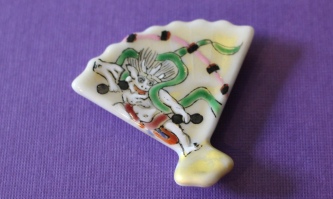 Raijin, the first deity, is the Japanese god of thunder, storms and lightening. He is often depicted carrying dumbbell-shaped hammers, as he is here, and you can just make out the canopy of drums that he uses to make thunder floating above his head. Japanese parents tell their children to hide their belly buttons during thunderstorms because rumor has it that Raijin likes to eat the navels of little children.
Raijin, the first deity, is the Japanese god of thunder, storms and lightening. He is often depicted carrying dumbbell-shaped hammers, as he is here, and you can just make out the canopy of drums that he uses to make thunder floating above his head. Japanese parents tell their children to hide their belly buttons during thunderstorms because rumor has it that Raijin likes to eat the navels of little children. wind above his shoulders, as he does here, and is often shown wearing a leopard skin.
wind above his shoulders, as he does here, and is often shown wearing a leopard skin.